By Elizabeth Dunlop Richter
For 178 years, Illinois’ St. Andrew’s Society, better known as Chicago Scots, has honored all things Scottish. Its annual Feast of the Haggis, held this year on December 2, naturally features the traditional dish made originally of ground sheep’s pluck (heart, liver, and lungs), oatmeal, suet and spices cooked in a sheep’s stomach, enhanced by a wee dram (or two) of single malt Scotch. But while the tastes and aromas of the feast delight, no Scottish celebration would be complete without the traditional sound and sight of the bagpipes.
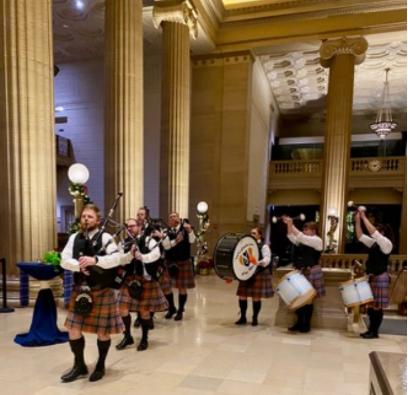
The Midlothian Scottish Pipe Band enters the majestic Wintrust Grand Banking Hall at the 2023 Feast of the Haggis
Whether you ascribe to the theory that bagpipes originated in Egypt or that the Roman emperor Nero forsook his fiddle for a set of bagpipes, all bagpipes have the same basic components. They consist of an airbag, one or more drones or pipes that maintain a constant tone and a chanter, an additional pipe that creates the melody. A blowpipe allows the piper to fill the bag with air. Pressure from the piper’s arm maintains a constant flow of air from the bag to the pipes, while the piper creates the melody on the chanter. Bags are made of animal skins, goat and cow most commonly. Some people use synthetic bags because they require less maintenance, but these can’t play at the highest level.
You may have first heard a bagpipe in the film “Braveheart,” where bagpipe music accompanies the fierce battle scenes. Few people know, however, that the bagpipe track in the film was not in fact played on a Scottish bagpipe seen in the movie, but on Irish bagpipes known as Uilleann pipes, with a unique sound facilitated by a two-octave range and a bag filled by bellows rather than a blowpipe. Variations on the bagpipe are found throughout Europe, probably spread by the Roman Empire.
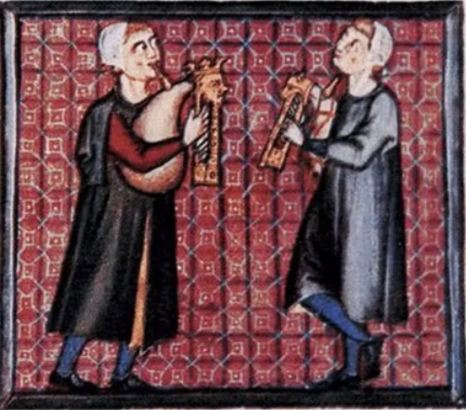
An illustration in the Cantigas de Santa Maria, a 13th century book of poems
The bagpipes one hears at Chicago Scots events and generally in Chicago are the Scottish Great Highland bagpipes with a nine-note range. Learning how to play this ancient instrument came early for Tristan Wilson, today the pipe major of the Midlothian Scottish Pipe Band, featured at the Feast of the Haggis. His grandfather was a piper, his father was a drummer and various other family members play one or the other. “There comes a time in every Wilson’s life when he has to choose…” either to play the bagpipes or the drums. At eight or nine years old, he and a friend were promised a playdate after a bagpipe lesson. “[The lesson] was something I got to do, not something I had to do,” he said.
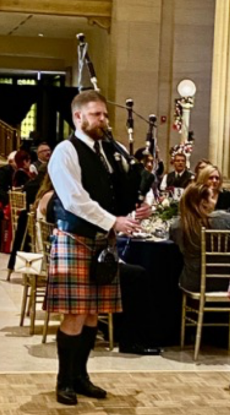
Tristan Wilson leads the Midlothian Scottish Pipe Band at the Feast of the Haggis
Wilson has played the bagpipes ever since. For him, piping is all about the people. “The biggest appeal is the community. In my family band there was a total cross section of society… if you can play, you are welcome… you’re all trying to make music at the exact same time… In my work as an engineer, all the skills that I got from being in this band are extremely valuable… I’ve found that band rehearsal is very mentally and emotionally beneficial. You’re doing something you really enjoy…it’s centering. No matter what’s going on in your mind, when you pick up your instrument and play with a group, you just can’t focus on all the noise in your life. It’s really cathartic.”
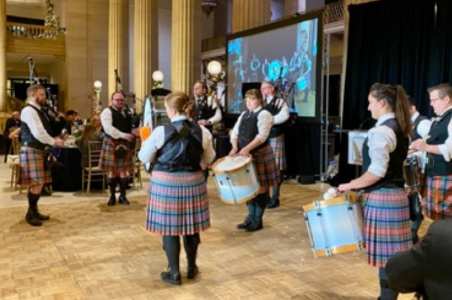
Members of the Midlothian Scottish Pipe Band play at the Feast of the Haggis
The Midlothian Scottish Pipe Band was founded in 1975, the top band in the U.S. for a number of years. Co-founder Ian Swinton and his family all played the bagpipes and when Swinton and drummer Jim Sim were offered a free place to practice in Midlothian IL, the band had a place to rehearse and give lessons. Today the band has about 25 members, many related to the Swinton family, some from as far away as Kansas City. “It was originally founded to bring more excellent high caliber competition music to the area,” said Wilson. Other bands are more focused on public performance, like the (Irish) Shannon Rovers.
Pipe bands from all over the world compete in carefully calibrated categories, from one down to five. The top grade requires the most complicated music and exact precision. The Midlothian group was winning grade two competitions before the pandemic, attending the world championships in Scotland. Now they are working to qualify again for the top of grade two. It’s taken a while to recover from the impact of Covid. The categories are determined by the pipe band associations. There are only two grade one bands in the United States today, in Texas and Florida.

Jim Sim, President of the Midwestern Pipe Band Association and drummer Calum MacRitchie at the Feast of the Haggis
Jim Sim, now President of the Midwestern Pipe Band Association comprising about 50 bands throughout the Midwest, oversees seven competitions during the year. Last year Chicago Scots ran the largest competition in North America at the summer Highland Games in Itasca. The national championship is held annually in August in Glasgow, Scotland. Sims has a unique way of evaluating the quality of a pipe band. “I don’t think there’s more stirring music when it’s played well and I don’t think there’s a worse music when it’s not played well! …There’s a reason they brought the pipes into wars. It inspired the troops…I can tell you when a really good band comes in, the hair on the back of my neck stands up.”
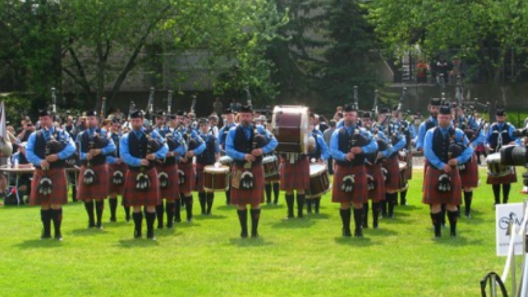 Alma College Pipe Band Festival 2012
Alma College Pipe Band Festival 2012
The Feast of the Haggis attracts serious fans of the bagpipe, even those who don’t play them. Gus Noble, OBE and president of Chicago Scots, participates in a different kind of Scottish music, “I love bagpipes but unless it’s got strings, I can’t play it. I tried, I failed. I play in a Scottish American Honky Tonk band…. I love bagpipes, they are such a stirring sound.” The Feast of the Haggis featured other musicians in addition to bagpipers. Renowned Scottish fiddler Alasdair Fraser accompanied the Thistle and Heather Highland Dancers and later joined award-winning classical violinist Rachel Barton to close the evening with some rousing Scottish tunes. The program ended on a celebratory note. Gus Noble had just privately announced, now public, that the organization had received a transformational gift of $14 million from the Negaunee Foundation to support Chicago Scots’ Senior Living and Memory Care facility.
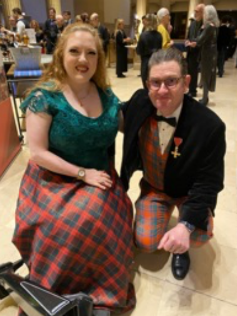 Violinist Rachel Barton and Chicago Scots President Gus Noble
Violinist Rachel Barton and Chicago Scots President Gus Noble
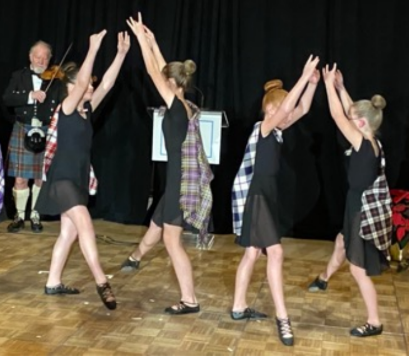 Thistle and Heather Highland Dancers accompanied by Alasdair Fraser
Thistle and Heather Highland Dancers accompanied by Alasdair Fraser

Curtis Drayer (l) and Jim Alexander, recipient of the Chicago Scots Distinguished Citizen Award in 2021
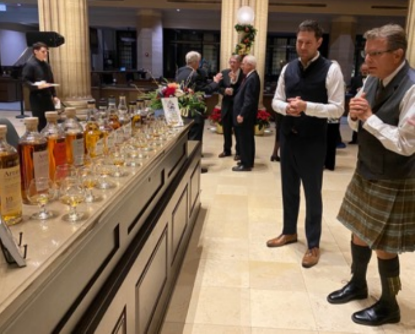
Single malt Scotch tasting bar |

The Fraser Family |
 Women have always been welcome in the Midlothian Pipe Band
Women have always been welcome in the Midlothian Pipe Band
As Tristan Wilson pointed out, anyone with an interest can learn to play the bagpipes and join a band. Women were once excluded but no more. The Midlothian band was a pioneer in admitting women, and they are drummers as well as pipers. If someone wants to learn, Midlothian in collaboration with Chicago Celtic offers lessons. Perhaps surprisingly, playing the bagpipe can also help one get into colleges. Yes, bagpipe scholarships available! Sim said, “we have a few colleges that are our sponsors to get the word out: Alma in Michigan, Monmouth in Illinois, Lion in Arkansas, St. Andrews in South Carolina.”
Wilson sums up the benefits of playing the bagpipes, “The most important thing for me is that it’s something that you can do at any age and for your whole life. I can be playing with my father, my son, and my grandpa at the same time. Like golf – another Scottish sport!”






